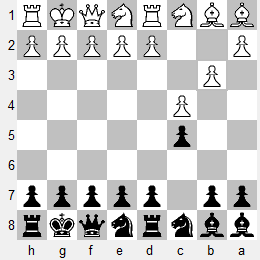Since elapsed times from LSS games are recorded along with the moves, it occurred to me to use the players' thinking time in the opening to pinpoint positions that they found difficult. As I discussed in my first post about LSS, The Lechenicher SchachServer, the site uses the 'countdown time control', where each player starts with a fixed amount of time that is never augmented, similar to a sandglass timer. If a player uses more time than originally allocated, the game is lost on time forfeit. Reflection time is precious and shouldn't be squandered.
While there are many reasons a player might use more time for a single move, like having higher priorities for the moment than working on a chess game, elapsed time is still a useful guideline. The players were assigned SP144 BBNRNQKR for their two games with each other. In one game, after 1.c4 c5 2.b3, the position shown in the diagram was reached. Black spent a relatively large amount of time on the next move. What would you play?
1. LSS Chess960 Final
C.Zolendowski - V.Nemchenko

After 2.b2-b3
Black, the higher rated player by about 200 points, played 2...e5. The move might seem surprising, since it creates a hole on d5, but it achieves two positional objectives:-
-
It stops d2-d4, a natural move for White with the Rook sitting on d1.
- It cuts the a1-h8 diagonal, where the Bishop on a1 is aimed at the likely future position of Black's castled King.
For his next move, White also gave the position considerable thought and finally played 3.Nf3, attacking the e-Pawn. The game continued 3...f6 4.e3 b6 5.Nh4 Ne7 6.Ne2 Qf7 7.Nf5. Here Black again thought for a longer time than on most of his other moves. After 7...Nxf5 8.Bxf5 d5 (Eliminating the backward d-Pawn after another long thought.) 9.cxd5 Bxd5 10.Nc3 Be6 11.Bxe6 Qxe6 12.e4 Nc7 13.Qe2 O-O 14.O-O, both players have castled and the position could have arisen from the traditional start position.
With the players castled, it's clear that Black has the better position. White's d-Pawn is backward on an open file and will be a problem for many moves. White kept finding counterplay, but was eventually overwhelmed and resigned on the 77th move, far behind on the clock along with a lost position.

1 comment:
What an interesting game thanks Mark.
You say that by move 14 the same position could have been reached from standard chess and while that might be technically true, if I look at blacks dark bishop it is on an unusual square and later does a job that I have NEVER seen in standard chess.
At move 36 black plays 36...Rg3 supported by that bishop (a really nice idea) that is really unusual and I personally think might be unique to Chess960.
Enjoy.
Post a Comment